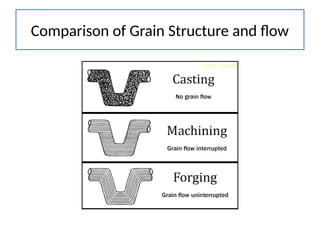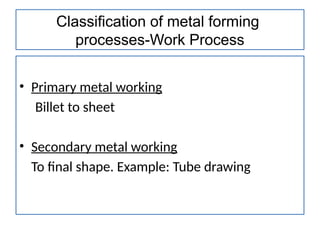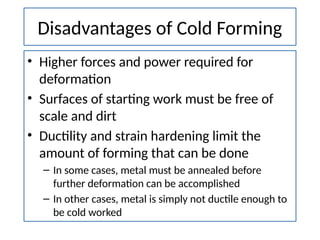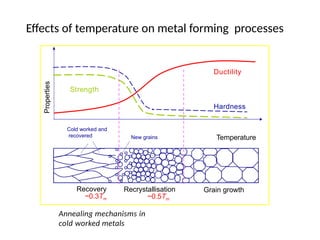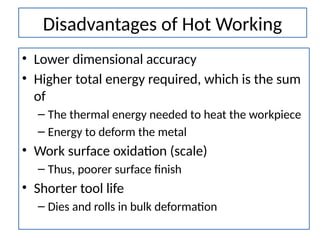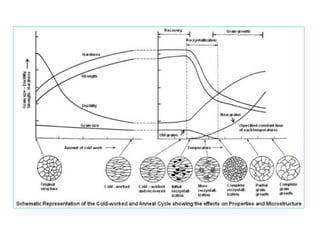Introduction to Metal Forming Processes – A detailed exploration of key metal forming techniques, focusing on deformation principles, material properties, and industrial applications.
- 1. Comparison of Grain Structure and flow
- 2. Material Properties • Desirable material properties: 1. Low yield strength 2. High ductility • These properties are affected by temperature: 1. Ductility increases and yield strength decreases when work temperature is raised. • Other factors: 1. Strain rate and friction
- 3. Classification of metal forming processes-Work Process • Primary metal working Billet to sheet • Secondary metal working To final shape. Example: Tube drawing
- 4. Classification of metal forming processes-Temperature • Hot forming • Cold forming • Warm forming
- 5. •The methods used to mechanically shape metals into other product forms are called Working Processes. Working processes Cold working Hot working T ~ 5  ï€ï€°ï€®ï€¸Tm T ï‚£ Tm Working processes based on Temperature Hot working (0.5-0.8Tm) Definition : deformation under conditions of temperature and strain rate such that recrystallization process take place simultaneously with the deformation. Examples : rolling, forging, extrusion Cold working (< 0.3Tm) Definition : deformation carried out under conditions where recovery processes are not effective. Examples : rolling, forging, extrusion, wire/tube drawing, swaging, coining Warm working T ~ 35  ï€ï€°ï€® Tm
- 6. Cold Working • Performed at room temperature or slightly above. • Many cold forming processes are important mass production operations. • Minimum or no machining usually required – These operations are near net shape or net shape processes
- 7. Advantages of Cold Forming • Better accuracy, closer tolerances • Better surface finish • Strain hardening increases strength and hardness • Grain flow during deformation can cause desirable directional properties in product • No heating of work required
- 8. Disadvantages of Cold Forming • Higher forces and power required for deformation • Surfaces of starting work must be free of scale and dirt • Ductility and strain hardening limit the amount of forming that can be done – In some cases, metal must be annealed before further deformation can be accomplished – In other cases, metal is simply not ductile enough to be cold worked
- 9. Warm Working • Performed at temperatures above room temperature but below recrystallization temperature • Dividing line between cold working and warm working often expressed in terms of melting point: – 0.3Tm, where Tm = melting point (absolute temperature) for metal
- 10. Advantages & Disadvantages of Warm Working • Advantages – Lower forces and power than in cold working – More intricate work geometries possible – Need for annealing may be reduced or eliminated • Disadvantage – Workpiece must be heated
- 11. Hot Working • Deformation at temperatures above the recrystallization temperature – Recrystallization temperature = about one half ‑ of melting point on absolute scale • In practice, hot working usually performed somewhat above 0.5Tm • Metal continues to soften as temperature increases above 0.5Tm, enhancing advantage of hot working above this level
- 12. Hot working Metal Melting point (oC) Recrystallisation temperature (oC) Hot working range (oC) Iron 1535 450 900-1200 Copper 1083 200 650-900 Aluminium (alloys) 660 150 350-500 Zinc 420 20 110-170 •Hot working involves deformation at temperatures where recrystallisation can occur (0.5-0.8 Tm). Examples of hot working temperatures for each metal
- 13. Effects of temperature on metal forming processes Ductility Hardness Strength Grain growth Temperature Properties Cold worked and recovered New grains Annealing mechanisms in cold worked metals Recovery ~0.3Tm Recrystallisation ~0.5Tm
- 14. Recrystallisation during hot working •The minimum temperature at which reformation of the crystals occurs is called Recrystallisation Temperature. •Above the recrystallisation temperature the kinetic energy of atoms increases and therefore they are able to attach themselves to the newly formed nuclei which in turn begin to grow into crystals. This process continues until all the distorted crystals have been transformed. •Hot working results in grain refining. Deformed in direction of work Nuclei form at grain boundaries at points of max stress Nuclei grow into new grains
- 15. Why Hot Working? Capability for substantial plastic deformation - far more than is possible with cold working or warm working • Why? – Strength coefficient (K) is substantially less than at room temperature – Strain hardening exponent (n) is zero (theoretically) – Ductility is significantly increased
- 16. Advantages of Hot Working • Work part shape can be significantly altered • Lower forces and power required • Metals that usually fracture in cold working can be hot formed • Strength properties of product are generally isotropic • No strengthening of part occurs from work hardening – Advantageous in cases when part is to be subsequently processed by cold forming
- 17. Disadvantages of Hot Working • Lower dimensional accuracy • Higher total energy required, which is the sum of – The thermal energy needed to heat the workpiece – Energy to deform the metal • Work surface oxidation (scale) – Thus, poorer surface finish • Shorter tool life – Dies and rolls in bulk deformation
